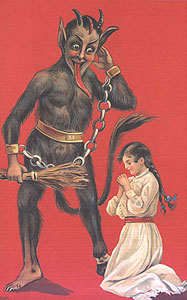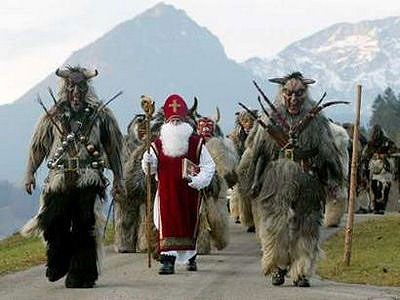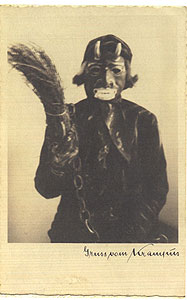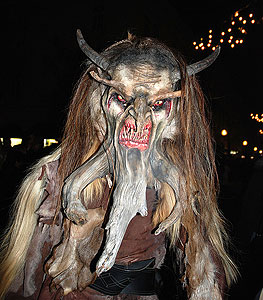Ancient Traditions: A Krampus Primer
Published on December 10th, 2012 in: Culture Shock, Holidays, Horror |
Image from Krampus.com,
courtesy of Monte Beauchamp’s
Krampus: The Devil of Christmas
You might have the word “Krampus” around the Internet lately and wondered what it meant. It’s something I only discovered last December and have always meant to investigate further. Luckily, dear readers, you can now benefit from my research into this ancient tradition!
Wikipedia has a brief, but helpful description: “Krampus is a beast-like creature from the folklore of Alpine countries thought to punish bad children during the Christmas season, in contrast with Saint Nicholas, who rewards nice ones with gifts. Krampus is said to capture particularly naughty children in his sack and carry them away to his lair.”
This sounds absolutely amazing to me. The website Krampus.com has an even more detailed and frankly disturbing description which details that the creature is “the dark companion of St. Nicholas” and often depicted as a devil-like beast with “horns, cloven hooves, and a monstrous tongue.” Not only does Krampus punish bad children, he also “swat[s] them with switches and rusty chains before dragging them in baskets to a fiery place below.” This actually reminds me of the demon figure in Insidious, which, Darth Maul jokes aside, scared the crap out of me for months.

The site goes on to state that sometimes Krampus is shown as a “sinister gentlemen dressed in black” or a “hairy man-beast.” All of these sound scary to me, but the “hairy man-beast” recalls the image of a satyr, ancient Greek mythology’s half horse/half man (not to be confused with a centaur or a faun).
The Irregular Times website (which tends to be slow, so be patient), has a long, fascinating account of just how far back the Krampus mythology extends. Despite the creature’s more modern (relatively speaking) association with St. Nicolas and Santa Claus, his existence dates to thousands of years before the existence of Christianity (itself a fairly young religion).
In the article “Merry Krampusnacht!” writer J. Clifford compares Krampus to not only satyrs but also Loki, the Norwegian trickster god. In fact, the article states the following, which has pissed off at least one person in the comments: “Krampus is often described as a spirit of Christmas, but in truth, the character of Krampus is deeper than Christmas. Krampus is a part of the ancient Yule holiday that is the true source of Christmas, and has meaning that clearly has nothing to do with Jesus.”
I don’t want to pit religions (or believers) against each other. Last December, NPR ran a story on Krampus and the comments section erupted into a flame war including pagans, Christians, and atheists.

Image from Krampus.com,
courtesy of Monte Beauchamp’s
Krampus: The Devil of Christmas
Granted, a few commenters who have personal cultural experience with Krampus bemoaned the watered-down, misunderstood, commercialized aspects of the Krampus tradition. Apparently, the creature’s holiday, Krampusnacht, which takes place on the eve of December 6—the day before St. Nicholas’s feast day—has become less about tradition and more of an excuse for idiots to get wasted and terrorize the streets. (As a native New Orleanian, I have immense disgust and frustration towards the Girls Gone Wild-ing of Mardi Gras, so I sympathize.)
Regardless, in a more perfect world, Krampusnacht and all its associated traditions would be more deeply understood and cherished. First of all, it’s not pronounced “CRAM-puss” but “Krahm-POOS.” As for the celebration itself, Krampus.com explains some of the historical basis:
The European practice of mummery during the winter solstice season can be traced back tens of thousands of years. Villagers across the continent dress up as animals, wild-men and mythic figures to parade and perform humorous plays. This ancient guising and masking tradition continues to this day as the primary source for our modern Halloween with its costumes, trick-or-treat, and pagan symbolism. Among the most common figures in these folk rituals were Old Man Winter and the horned Goat-Man—archetypes now found in the forms of Saint Nick/Santa Claus, and the Devil (‘Old Nick’), aka Krampus.

Photo © gholzer
As both Krampus.com and the Irregular Times point out, there has also been crossover between Santa Claus/St. Nicolas and Krampus, resulting in the “evil Santa Claus” images that have been seen in films like Rare Exports and Sint (I haven’t seen the former, but the latter film is great).
What does Krampusnacht look like? It depends upon where you go. Like Krampus.com points out, there are variations of Krampus throughout Europe$mdas;Knecht Ruprecht in Germany, Certa in Italy, Perchten in Austria, Black Peter in the Netherlands, Schmutzli in Switzerland, Pelznickel in Southern Germany, and Klaubauf in Bavaria.
The first Krampusnacht celebration I saw (sadly, not in person but on YouTube) is this one from Austria, posted in an io9 article called ” Austria’s Krampus Parade celebrates Santa’s child-eating monster.” It’s pretty fantastic, especially because it’s snowing when all the festivities are taking place.
There is so much more to be said about Krampus, not the least of which the insane amount of artistry that goes into the costumes and masks (many of which are carved out of wood). For starters, you should check out the links on Krampus.com to other sites, as well as their gallery of Krampus postcards and videos. Surprisingly, a Google Image search of “Krampus” leads to a lot of interesting, informative articles, like this one from Lady Lavona’s Cabinet of Curiosities.
Unfortunately, Krampusnacht has passed this year, but that gives you a head start on planning your own Krampus celebrations for 2013. Merry (Belated) Krampusnacht and Happy Holidays!
Time limit is exhausted. Please reload the CAPTCHA.